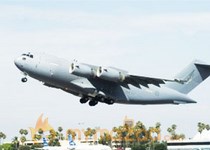India has sealed its biggest $4.1 billion deal with the US for 10 Boeing C-17 heavy-lift aircraft by signing a formal agreement that envisages delivery of the planes before 2015, government and company officials said Wednesday.
“The ministry of defence has signed a letter of offer and acceptance for procurement of 10 C-17 Globemaster III heavy transport aircraft and associated equipment from the US government for the Indian Air Force (IAF) at a cost of $4.1 billion. The agreement was signed Tuesday evening,” government officials said here.
Acknowledging the deal, Boeing said in a statement that India will take delivery of the aircraft, powered by four digitally-controlled Pratt and Whitney’s engines, under the Foreign Military Sales (FMS) route of the US government in 2013-14.
The procurement will meet the growing heavy airlift needs of the Indian armed forces.
“The aircraft is being offered in its latest US Air Force configuration, duly customised as per IAF requirements,” defence ministry officials said, noting tht the delivery of the entire fleet would be completed within four years.
Boeing would also meet an offset obligation comprising 30 percent of the basic cost of the 10 aircraft, which would work out to about $1 billion, the officials added. The basic cost, without the associated equipment and training costs for IAF personnel, would work out to about $3 billion, they added.
The offset obligation arises out of the Indian defence offsets guidelines that mandate the ploughing back of a part of every deal amount in India’s defence industry.
“In addition to the purchase of products and services from public and private Indian defence industries, Boeing will establish a high-altitude engine test facility at the Defence Research Development Organisation (DRDO),” India’s premier military technology developer, the officials said.
This facility is not available in India and will enable aeroengines to be tested within the country.
“Boeing will also establish a trisonic wind tunnel facility at DRDO to enable testing, research and development of various aerodynamic bodies,” the officials added.
India’s cabinet committee on security (CCS) last week gave its go ahead for the C-17 deal. The US Congress had approved the sale in May 2010.
With this contract, India has become the largest international customer of C-17s, which can carry a payload of 75 tonnes and can land and take-off from airstrips of 3,000 feet. A tactical and strategic airlifter, the C-17 can land combat-ready troops in remote locations or airdrop them directly where needed. The C-17’s ability to back up allows it to operate from narrow taxiways and congested ramps.
“The C-17 will elevate India’s leadership in the region,” Boeing India’s president Dinesh Keskar said in the company’s statement.
“The aircraft’s ability to transport large payloads across vast ranges, land on short, austere runways, and operate in extremely hot and cold climates makes it ideal for the region,” Jean Chamberlin, Boeing Mobility vice president and general manager, said.
Boeing will support India’s C-17 fleet through the C-17 Globemaster III Sustainment Partnership (GSP), a multinational performance-based logistics programme, the company said.
The GSP “virtual fleet” arrangement ensures mission readiness by providing all C-17 customers – with varied fleet sizes – access to an extensive support network for worldwide parts availability and economies of scale when purchasing materials.
“We look forward to partnering with India as we move forward with the agreement’s 30 percent offset program, which will help strengthen India’s aerospace and defense capabilities,” Boeing Defence, Space and Security vice president for international business development Mark Kronenberg said.
Boeing has delivered 232 C-17s, including 210 to the US Air Force and National Guard and 22 to international customers such as the Royal Air Force, the Qatar Emiri Air Force, the Canadian Forces, the Royal Australian Air Force, the 12-nation members of Strategic Airlift Capability initiative of NATO and Partnership for Peace, and the United Arab Emirates Air Force and Air Defence.







